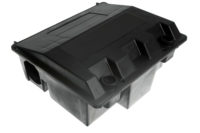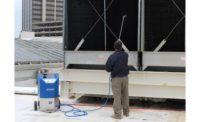4 Steps to Strategic Sanitation Risk Assessment

While some foods pose inherently higher risk profiles for microbiological contamination than others, all food processing operations must adhere to stringent process control and food safety best practices in order to ensure that all finished product is safe and wholesome for human consumption. Indeed, each food type and process has a unique set of potential contamination points of concern that can cause sleepless nights for professionals in charge of the departments of food safety, quality control and quality assurance in a food manufacturing facility. We know that the food processing environment can provide adequate time, moisture, nutrients and other essentials that will allow pathogenic and spoilage bacteria to flourish even when the best food safety controls are in place.
Fortunately, we also know that the plant sanitation program is one of the most effective ways to ensure that the risk of potential product contamination is minimized. But how do we know that our sanitation efforts are truly effective? A properly executed risk assessment of your sanitation process can help you to determine the true efficacy of your operation’s sanitation process. The following four steps are designed to help food safety, quality assurance and sanitation professionals better assess the efficacy of sanitation activities. This step-by-step strategy is easy to incorporate into your operation’s routine in-house sanitation audits or even to request from your third-party auditor—and will help food safety professionals get a better night’s rest.
Step 1: Post-Operational Sampling
The first step in a solid risk assessment of the efficacy of sanitation is one of logistics. You must have the opportunity to evaluate the manufacturing process as it exists prior to post-operational cleanup. This means making enough time between the production shift and the arrival of the sanitation crew to take environmental hygiene samples in order to enumerate and therefore create a “photograph” of the microbial load at the time of the end of the run. Taking environmental samples of equipment and targeted locations in the production area such as drains, floors, walls and adjacent fixtures, will help to determine efficacy of sanitation by establishing a baseline of data for comparison. Eventually. we want to compare the environmental hygiene results from the worst-case scenario (i.e., dirtiest surfaces post-production run) against the best-case scenario (i.e., cleanest surfaces post-sanitation activities) data.
In addition to establishing a baseline for data comparison, another reason for this first step is that the auditor may have come across an area in the process that bears further investigation. Microbial growth niches may be discovered and Hazard Analysis and Critical Control Point (HACCP) plans may eventually be altered due to these observations. Therefore, this post-op interval is critical to a good risk assessment of the sanitation process.
Assuming there is no indication of an immediate problem with a particular pathogen that requires critical and immediate intervention, most situations call for simple microbiological “background” checks. This will often entail the use of aerobic plate counts (APCs) and coliform assays. These test requirements may differ depending upon the individual process and thus will be decided on a case-by-case basis.
Step 1 can be quite difficult to achieve because there are often plant personnel on very tight schedules with a very real need to quickly complete the sanitation process and make more product to be shipped. It is therefore important to have the assistance (and blessing) of upper management when attempting to acquire post-op samples. It is also important to use the correct environmental hygiene monitoring screening or test methods for your type of process, whether those are swabs, sponges, paddles, slides, strips or other diagnostic test kit tools, and to use the same sampling technique for Step 1 as Step 3.
Step 2: Observe the Sanitation Process
The second step is to observe the entire sanitation process to ascertain whether there are any food safety risk factors in the cleaning and sanitizing activities themselves. First, observe the actual cleaning of the equipment. Note which items are being cleaned in place and which are being dismantled and cleaned. In addition, and most importantly, note which items appear to be neglected. This is a difficult thing to ascertain and often requires some historical information about the equipment. Ask the managers and supervisors to explain why a certain piece is not being cleaned. Answers such as “We never clean that, it’s too hard to take apart” or “That has never been cleaned and we have never had a problem before” are immediate red flags. When in doubt, find a veteran maintenance person and learn the history of the equipment in question. Question him or her about the age of the piece, when was it last dismantled and cleaned (if ever) and whether its design has been altered in any way. Design changes may indicate the possibility of new growth niches and therefore new challenges to sanitation that translate to food safety risk. Don’t be surprised if you get myriad answers to such questions. This is where a new set of eyes (i.e. an independent observer) can be very helpful.
Second, make sure to observe the maintenance of water temperature throughout the sanitation shift. Lipids and biofilms are not removed by detergents or sanitizers alone. Furthermore, biofilms protected by a cover of fat will likely remain a thorn in your side for a very long time unless you use the proper water temperature during cleaning and sanitizing. There is much controversy about the subject of water temperature but many experts agree that temperature may be the single most important aspect of effective sanitation. Very simply, I would suggest the following two rules of thumb:
(A) Stainless steel objects must reach a surface temperature of 140F for removal of fats.
(B) To achieve (A), water temperature at the hose nozzle exit should be 160F.
Of course, anything dismantled and cleaned out of place should be easily sanitized at these temperatures. But there are problems achieving and utilizing these temperatures. First and foremost, the sanitation crew has to endure an ordeal every night (or day) trying to handle and manipulate hoses that are so hot. But it can be done. There are hoses and even complete systems on the market that can alleviate this problem. Protective clothing, face guards and specialized spray handles are available. Second, some water heating systems cannot keep up with the demand for steam and hot water needed to accomplish the job. Obviously, upgrading the system can be cost prohibitive. This is where a manufacturer may have to make a big decision. Third, avoid overheating by using raw steam or other such extreme measures that risk causing permanent damage to your non-metal equipment and by virtually baking residues onto surfaces. Always consult the equipment manufacturer (or a competent engineer) when attempting to change sanitization temperatures.
Of course, during step two of the risk assessment, you will want to observe other parameters. For example, it is important that cleaners and sanitizers be used according to specifications for your particular process. Concentration (i.e. parts per million) and pH can make big differences in the effectiveness of your sanitizers. Chlorine-based sanitizers, for example, often require ~200 ppm at a very specific pH to remain effective. Many people make the mistaken assumption that more is better. It is best not to second guess the specifications set forth by the sanitizer company. Another important thing to remember is that chlorine and other sanitizers tend to lose their effectiveness when they encounter organic materials, such as your product. The heavier the load, the less effect rendered. These parameters can be easily monitored periodically during the sanitization process by using prepackaged strips designed to measure potency and pH.
Step 3: Pre-Op Sampling
Now is the time of reckoning. Or is it? What if environmental sampling by pre-operational sponges shows your sanitation process to be immaculate? What if everything comes out perfectly “clean,” microbiologically speaking? Have all the perceived “growth niches” been sanitized? What about non-product surfaces and/or product surfaces that might become contaminated during the next run?
The point here is that some microbes won’t show up until after start-up, which is why pre-operational sampling should be included as part of the risk assessment of the sanitation process. For example, vibrations and air currents created by the manufacturing process may help to draw these contaminants out of the niches in the equipment and into the product stream. These problem areas can consist of ball valves, gaskets, slicing blade housings and a host of other potential growth niches. It is thus highly recommended to take samples during operations—but not just the routine samples that most companies employ. One should now add (where physically possible) a sampling step for any potential or newly identified growth niche areas detected during the post-operational assessment (Step 1). These environmental samples may be taken several hours into the production run so that the data obtained reflects whether process points of risk exist or are being created in the production itself.
Step 4: Compare Data and Establish a Baseline
At this final step, you will use the information gathered in Steps 1 to 3 to compare data to determine the true efficacy of the sanitation process. Of course, due to the vast differences in protocols for environmental sampling, the baseline established will likely be different for every process. However, for the sake of illustration (and of sanity), let’s assume that we want to compare data we’ve obtained for a specific one square foot surface of a particular piece of equipment. We used a pre-sterilized sponge as our sampling method for both the post-operational and pre-operational steps (Steps 1 and 3), and we have records of the observational data noted during Step 2.
In general, we can use data from the first three steps to identify a baseline from which to judge the level of microbiological risk that exists or potentially exists relative to this piece of equipment:
• Step 1 (Post-op): Aerobic plate counts (APC) of above 10,000 should give cause for concern, and 100,000 APC or more should be considered a growth niche. This area should be heavily monitored until the numbers are brought under control.
• Step 2 (Observation): Evaluate water temperature, concentrations and pH. These and other parameters will have an impact upon whether changes to the system are needed, especially when data out of specification corresponds with high microbial numbers. If our observational data indicates that during the cleaning of this piece of equipment the water temperature fluctuated to such a degree that it mitigated the effectiveness of the sanitizing agent, we will likely not be surprised to see high microbial counts from the Step 3 results.
• Step 3 (Pre-op): Aerobic plate counts of <100 CFU and coliform counts of <10 cfu should be expected for thorough and complete sanitation. APCs >1,000 and/or coliforms >10 will need immediate attention. Obvi-ously, anything found in high microbial numbers during Step 1 should be of particular concern for follow-up investigation and testing.
By comparing the data and establishing a simple baseline, we can now better determine whether our sanitation activities are truly efficacious. If not, we have identified areas of risk either from the production process, the sanitation process or both, and that information is invaluable in devising improved ways to prevent microbial contamination.
Sleep Better at Night
Ultimately, it is better to be sanitation-secure than sleepless in Seattle, Cinninati or Savannah. By using this four-step risk assessment strategy, you have monitored the sanitation process from A to Z with a bonus: You have unveiled some nuances of an entire manufacturing run. While these microbiological results may not take into account cross-contamination events that might occur during manufacturing, they should provide helpful insights to improve the effectiveness of your sanitation process and peace of mind.
Robert Behling is the founder of Behling Food Safety, a Madison, WI-based independent consulting firm in the food safety industry with an emphasis on microbiological contamination and sanitation issues. He has more than 18 years of experience in the area of food manufacturing and food safety. Bob began his career in 1988 as head of R&D and production of MicroGard for Wesman Foods in Beaverton, OR. He has since investigated contamination issues while employed as manager of client services at Silliker Laboratories, and helped to train hundreds of food production personnel and participated in the training of managers and supervisors for the newly established Serbian Microbiological Reference Laboratory through the USDA Foreign Agricultural Service.
Looking for a reprint of this article?
From high-res PDFs to custom plaques, order your copy today!









